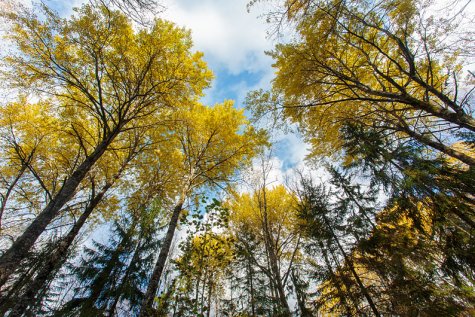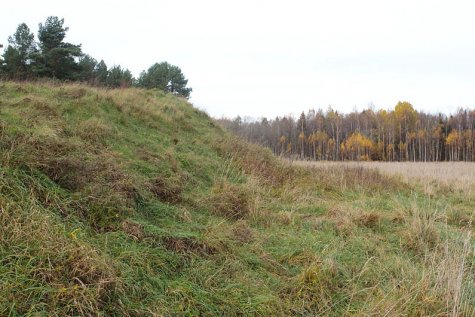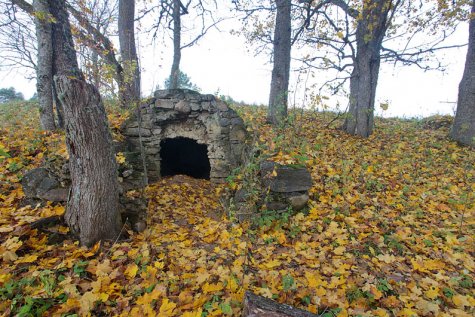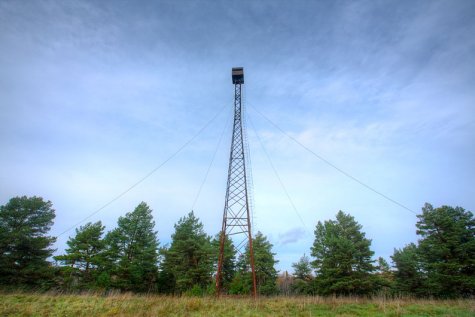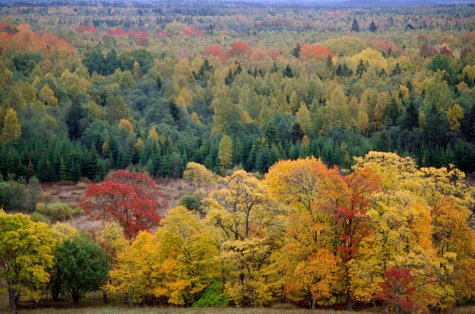Alam-Pedja lood
Golden autumn at Madisemägi
Text: Margit Mõttus
Photos: Arne Ader and Fred Jüssi
Translation: Liis
On a sunny October morning we set off towards Madisemägi. Moving through the leaf-fall in the forest we take the time to make photos. And simply to admire. For instance how the wind ruffles the golden crowns of the high aspens. In the shrubs in the swamp forest tits and robins are calling, Twice a grouse or a capercaillie flies up at our steps.
Aspens in the Alam-Pedja swamp forest
After crossing the Pedja river by the swaying hanging bridge we are finally there.
The first impression of Madisemägi is something of a shock – in the midst of wide bogs and forests there really is a hill! Or then a hillock. But dry and firm. Despite the prevailing silence life throngs here, which the animal paths indicate that end here after crossing the hayfield on the hill. Paths with fresh tracks lead to the apple tree growing on the border between the farm lands and the swamp. It seems at the moment to be the most popular spot in the place. The ground under the tree is trampled even and the harvest meticulously picked.
Madisemägi is a flat hillock about 10 meters high, on the eastern border of the Umusi marsh. Geologists belive it to be a callus that has been heaped up by a glacial river. During archaeological excavations, 6000 years old flint shards were found that indicate that the site was inhabited at a time when Madisemägi was an island in the ancient Võrtsjärv. Later, already as a bog island, the hill has been used during times of war as shelter. In the old times a plank road is said to have existed between Pikknurme and Madisemägi.
The steep hillside on the Madisemägi eastern edge supports the theory that the ancient hill fortress may have been here. Currentknowledge confirms the natural origins of Madisemägi: the hillock has been mainly shaped by the glacial river that flowed towards the end of the Ice Age.
As memorials of gone times, the foundation remnants of the one-time Madise farm stand on the south-eastern border of the hill; at the top of the hill a metal tower and at the southern end of the hill a small timber house.
Local history investigator Ell Maanso writes about life in the former Madise farm; ”At Madise farm the main activities were growing corn and potatoes. Some years hard winds beat all down; then there was no harvest at all. 15 animals were kept over winter, 10 of them milk cows. There were no milk transports; butter was made at home. It was sold at the Tartu market. Butter from the summer period was sold in autumn and winter. A butter cellar was set deep in the hillside.“
Cellar from local stone in the former Madise farm yard
In 1951 all the buildings of Madise farm and the Utsali village were demolished. A training area for the Soviet bomber airplanes was created here. Three towers were erected on the area, one of them at Madisemägi. From the towers the felling precision of the dropped bombs was monitored.
Access to the whole area remained limited until the beginning of the 90s; common mushroom and berry pickers or just nature lovers had no business there.
We make a longer stop at the tower. Just to think and remember. Among other things, also to decide whether to climb the tower or not. A sign at the beginning of the tower stairs however tells drily that climbing the tower is at one’s own risk.
On October 4th 1992 Fred Jüssi writes in his trip diary: ”Beautiful weather, colour-filled forests. No rain during the whole day. The colours of the landscape have turned even more vivid, are simply startling. At Pedja and in the forests the aspens glow from lemon yellow to wine red, particularly amazing I think the colours are against the light, where they seem almost glowing.“
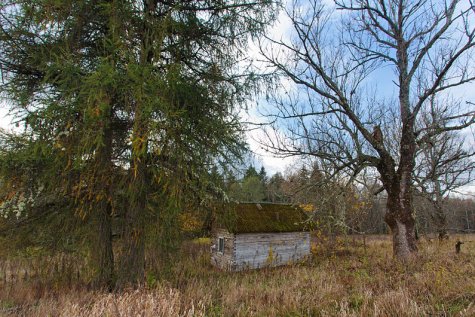 The former sauna of the forester station from the pre-war era of president Päts was later housing for soldiers and a living place for so-called Puurman Voitka fugitives. Now the door is open to hikers.
The former sauna of the forester station from the pre-war era of president Päts was later housing for soldiers and a living place for so-called Puurman Voitka fugitives. Now the door is open to hikers.
The doors of the sauna, eroded by time, at the foot of the hill are generously open. We enter and discover a visitor’s book on the table, page by page filled with enthusiastic entries.
We write our thoughts too in the book, with the desire to come back again. It makes one smile to see the entry of Vaido who has spent some time here: ”Had no peace for 2 weeks, here again now “.
More photos: LINK
Looduskalender’s Alam-Pedja stories are supported by the Keskkonnainvesteeringute Keskus, Environmental Investment Centre.

